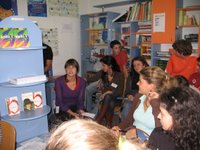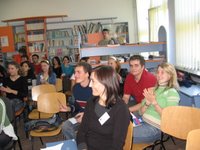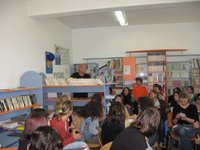By Alisia Muresan, 12th C
Borderline...the wall that we built between us, the barrier that separates our minds as well as our bodies, the appearances that we must fight against.
This is what we tried to do during our meeting with our colleagues from the project. After spending a wonderful day in which each team presented its work, our school organised a trip that, by taking us back in history helped us better understand the realities that we face today; a trip that showed our integrity as Romanians and our true character as humans.
It was also important due to the fact that we travelled along our border with Ukraine, and this way we had the possibility to observe how the people that live near borders get along and how this situation evolved in time, because our borders are not the same as were years ago.
We first visited what used to be the house of a historical personality from our county, Vasile Lucaciu. Known as “the lion of Sisesti”, he was a famous fighter for the rights of the Romanians from Transylvania. The ensemble that we visited includes: the parochial house, the school and The Church of the Saint Union of All the Romanians. Lucaciu was one of the fearless leaders of the Transylvanian fight for emancipation and he was one of the people who wrote the “Memorandum”, which contained historical arguments, the motives that stood as a base for the Romanians desire: not to annex Transylvania to Hungary.
After this, we had the chance to visit the famous wooden Church from Surdesti. It dates back to 1721 and it is remarkable due to the tower’s impressive dimensions. This church is known as the highest construction of wood from the whole world, the tower measuring 54 m. The beauty of the place is increased by the marvellous interior that has paintings with scenes from the Bible.
The Museum of Ethnography and The Village Museum are important sights for any Romanian. And especially we, the people from Maramures, have a lot to be proud of when we speak about The Village Museum from Sighetu Marmatiei.
At the entrance of this museum we are „welcomed” by the symbol-monument of central Europe, the point where the 0 kilometre is marked.
The Museum is composed of peasant architectural monuments, houses and churches, arranged in a village that reconstitutes the way that these peasants lived and were organized. This place creates such a strong impression of reality, which I confess that I sometimes felt like I have barely got out from a time machine that took me back in time, to those ages.
Of great importance are also the Gates from Maramures, which, for Europe, made a considerable contribution to enriching the cultural treasure of our ancient continent. This Gates separate the sacred space of the house and its surroundings from the outside space, representing the pride of the peasant as an inhabitant of Maramures.
What we visited next is also what impressed me the most: the Memorial from Sighetu Marmatiei, and some famous words that I read there will always remain in my memory:”He, who forgets the past, is condemned to repeat it” (Santayana) and “When justice does not succeed in becoming a form of memory, memory alone CAN be a form of justice”(Ana Blandiana). These words impressed me even more after I found out the history that they refer to.
Placed in the former "Prison of the Ministers" in Sighet, the MEMORIAL of the Victims of Communism and anticommunist Resistance was opened in 1997 in the town of Sighetu Marmatiei ("Sighet") located in the far North West, in the beautiful Maramures region.
The prison, which was active from 1897 until 1977, takes its name from the period during the 1950s when it held many political prisoners (former government ministers, generals, academicians, and religious leaders - the cultural and political elite of Romania) in terrible conditions - brought here because it was thought to be particularly secure since the town was just 2km from the Soviet frontier. 180 prisoners were held in terrible conditions in 72 cells. Many were elderly but this didn't save them from beatings and punishment so it is no surprise that many died. These included one of the most respected pre-war politicians.
The Memorial Sighet was established as a reminder of the atrocities committed by the communist regime - for years the population has been brain-washed to create the so-called "New Man" through the rewriting of history and poisoning the memories of generations. Moral and civic values could only be recovered if the collective consciousness is recuperated. The Sighet prison was chosen because it was the first of many political prisons set up in Stalinist times and because it was where the country's political, spiritual and cultural elite of the pre-war democracy was exterminated.
An International Study Centre was established here because out of all of the former communist countries, Romania's experience had been the longest and most painful.


